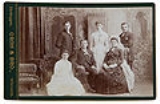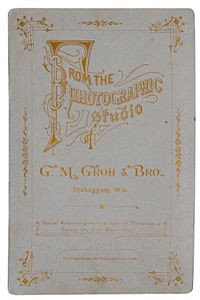
Cabinet card
Encyclopedia
The Cabinet card was the style of photograph which was universally adopted for photographic portraiture in 1870. It consisted of a thin photograph that was generally mounted on cards measuring 4¼ by 6½ inches.
 The Carte de visite
The Carte de visite
process was quickly replaced by the larger Cabinet cards. In the early 1860s, both types of photographs were essentially the same in process and design. Both were most often albumen print
s; the primary difference being the cabinet card was larger and usually included extensive logos and information on the reverse side of the card to advertise the photographer’s services. However, later into its popularity, other types of papers began to replace the albumen process. Despite the similarity, the cabinet card format was initially used for landscape views before it was adopted for portraiture.
Some cabinet card images from 1890s have the appearance of a black and white photograph in contrast to the distinctive sepia toning notable in the albumen print process. These photographs have a neutral image tone and were most likely produced on a matte collodion
, gelatin
or gelatin bromide paper.
Sometimes images from this period can be identified by a greenish cast. Gelatin papers were introduced in the 1870s and started gaining acceptance in the 1880s and 1890s as the gelatin bromide papers became popular. Matte collodion was used in the same period. A true black and white image on a cabinet card is likely to have been produced in the 1890s or after 1900. The last cabinet cards were produced in the twenties, even as late as 1924.
Owing to the larger image size, the cabinet card steadily increased in popularity during the second half of the 1860s and into the 1870s, replacing the carte de visite as the most popular form of portraiture. The cabinet card was large enough to be easily viewed from across the room when typically displayed on a cabinet, which is probably why they became known as such in the vernacular. However, when the renowned Civil War photographer, Mathew Brady
, first started offering them to his clientele towards the end of 1865, he used the term, "Imperial Carte-de-Visite." Whatever the name, the popular print format joined the photograph album as a fixture in the late 19th century Victorian parlor. Ironically, early into its introduction, the cabinet card ushered in the temporary demise of the photographic album which had come into existence commercially with the carte de visite. Photographers began employing artists to retouch photographs (by altering the negative before making the print) to hide facial defects revealed by the new format. Small stands and photograph frames for the table top replaced the heavy photograph album. Photo album manufacturers responded by producing albums with pages primarily for cabinet cards with a few pages in the back reserved for the old family carte de visite prints.
Ironically, early into its introduction, the cabinet card ushered in the temporary demise of the photographic album which had come into existence commercially with the carte de visite. Photographers began employing artists to retouch photographs (by altering the negative before making the print) to hide facial defects revealed by the new format. Small stands and photograph frames for the table top replaced the heavy photograph album. Photo album manufacturers responded by producing albums with pages primarily for cabinet cards with a few pages in the back reserved for the old family carte de visite prints.
For nearly three decades after the 1860s, the commercial portraiture industry was dominated by the carte de visite and cabinet card formats. In the decade before 1900 the number and variety of card photograph styles expanded in response to declining sales. Manufactures of standardized card stock and print materials hoped to stimulate sales and retain public interest in card photographs. However, as with all technological innovations, the public increasingly demanded outdoor and candid photographs with enlarged prints which they could frame or smaller unmounted snapshots they could collect in scrapbooks.
In no small part owing to the immense popularity of the affordable Kodak Box Brownie
camera, first introduced in 1900, the public increasingly began taking their own photographs and thus the popularity of the cabinet card declined.
Card stock
Card colours
Borders
Lettering
History

Carte de visite
The carte de visite was a type of small photograph which was patented in Paris, France by photographer André Adolphe Eugène Disdéri in 1854, although first used by Louis Dodero...
process was quickly replaced by the larger Cabinet cards. In the early 1860s, both types of photographs were essentially the same in process and design. Both were most often albumen print
Albumen print
The albumen print, also called albumen silver print, was invented in 1850 by Louis Désiré Blanquart-Evrard, and was the first commercially exploitable method of producing a photographic print on a paper base from a negative...
s; the primary difference being the cabinet card was larger and usually included extensive logos and information on the reverse side of the card to advertise the photographer’s services. However, later into its popularity, other types of papers began to replace the albumen process. Despite the similarity, the cabinet card format was initially used for landscape views before it was adopted for portraiture.
Some cabinet card images from 1890s have the appearance of a black and white photograph in contrast to the distinctive sepia toning notable in the albumen print process. These photographs have a neutral image tone and were most likely produced on a matte collodion
Collodion process
The collodion process is an early photographic process. It was introduced in the 1850s and by the end of that decade it had almost entirely replaced the first practical photographic process, the daguerreotype. During the 1880s the collodion process, in turn, was largely replaced by gelatin dry...
, gelatin
Gelatin-silver process
The gelatin silver process is the photographic process used with currently available black-and-white films and printing papers. A suspension of silver salts in gelatin is coated onto a support such as glass, flexible plastic or film, baryta paper, or resin-coated paper...
or gelatin bromide paper.
Sometimes images from this period can be identified by a greenish cast. Gelatin papers were introduced in the 1870s and started gaining acceptance in the 1880s and 1890s as the gelatin bromide papers became popular. Matte collodion was used in the same period. A true black and white image on a cabinet card is likely to have been produced in the 1890s or after 1900. The last cabinet cards were produced in the twenties, even as late as 1924.
Owing to the larger image size, the cabinet card steadily increased in popularity during the second half of the 1860s and into the 1870s, replacing the carte de visite as the most popular form of portraiture. The cabinet card was large enough to be easily viewed from across the room when typically displayed on a cabinet, which is probably why they became known as such in the vernacular. However, when the renowned Civil War photographer, Mathew Brady
Mathew Brady
Mathew B. Brady was one of the most celebrated 19th century American photographers, best known for his portraits of celebrities and his documentation of the American Civil War...
, first started offering them to his clientele towards the end of 1865, he used the term, "Imperial Carte-de-Visite." Whatever the name, the popular print format joined the photograph album as a fixture in the late 19th century Victorian parlor.

For nearly three decades after the 1860s, the commercial portraiture industry was dominated by the carte de visite and cabinet card formats. In the decade before 1900 the number and variety of card photograph styles expanded in response to declining sales. Manufactures of standardized card stock and print materials hoped to stimulate sales and retain public interest in card photographs. However, as with all technological innovations, the public increasingly demanded outdoor and candid photographs with enlarged prints which they could frame or smaller unmounted snapshots they could collect in scrapbooks.
In no small part owing to the immense popularity of the affordable Kodak Box Brownie
Brownie (camera)
Brownie is the name of a long-running and extremely popular series of simple and inexpensive cameras made by Eastman Kodak. The Brownie popularized low-cost photography and introduced the concept of the snapshot. The first Brownie, introduced in February, 1900, was a very basic cardboard box camera...
camera, first introduced in 1900, the public increasingly began taking their own photographs and thus the popularity of the cabinet card declined.
Timeline
- Introduced: 1866. First used for horizontal views, then eventually adapted for portraits.
- Peak popularity: 1880s. Although not uncommon in the 1870s, the cabinet card did not displace the carte de visite completely until the 1880s.
- Decline: 1890s. As snapshot and personal photography became commonplace among the public, the popularity of the cabinet card and cabinet card specific albums waned. Unmounted paper prints and the scrapbook albums started replacing them. A variety of other large card styles of various names and dimensions came about for professional portraits in the 1880s and 1890s. After 1900, card photographs generally had a much larger area surrounding the print quite often with an embossed frame around the image on heavy, gray card stock.
- Last Used: The cabinet card still had a place in public consumption and continued to be produced until the early 1900s and quite a bit longer in Europe. The last cabinet cards were produced in the twenties.
Dating a cabinet card
Attempting to determine the date of creation for a cabinet card can be gathered by the details on the card. The type of card stock or whether it had right-angled or rounded corners can often help to determine the date of the photograph to as close as five years. However, it has to be noted that these dating methods aren't always 100% accurate, since a Victorian photographer may have been using up old card stock, or the cabinet card may have been a re-print made many years after the photo was originally recorded.Card stock
- 1866-1880 Square, lightweight mount
- 1880-1890 Square, heavy weight card stock
- 1890s Scalloped edges
Card colours
- 1866-1880 Thin, light weight card stock in white, off white or light cream. White and light colours were used in later years, but generally on heavier card stock.
- 1880-1890 Different colours for face and back of mounts
- 1882-1888 Matte-finish front, with a creamy-yellow, glossy back.
Borders
- 1866-1880 Red or gold rules, single and double lines
- 1884-1885 Wide gold borders
- 1885-1892 Gold beveled edges
- 1889-1896 Rounded corner rule of single line
- 1890s on — Embossed borders and/or lettering
Lettering
- 1866-1879 Photographer name and address often printed small and neatly just below the image, and/or studio name printed small on back.
- 1880s on — Large, ornate text for photographer name and address, especially in cursive style. Studio name often takes up the entire back of the card.
- Late 1880s-90s Gold text on black card stock
- 1890s on — Embossed studio name or other embossed designs

